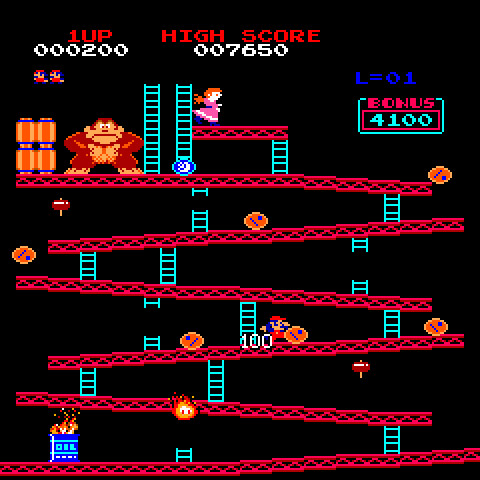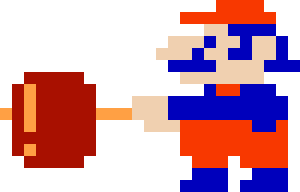Why Mario Has a Mustache

Pictured above is, perhaps, the most iconic video game character ever created. It’s Mario, of course, of Mario Bros. fame. The image above is the artwork from New Super Mario Bros. U Deluxe (via Wikipedia) but it does the job. There’s Mario — the hat-wearing, mustache-donning, blue-on-red overall-wearing video game hero we’ve all come to know and love.
But how did Mario get his outfit? Why does he have a hat? Or overalls? Or that’ stache? The short answer: because it made him easier to create.
Mario made his debut in the 1981 video game hit Donkey Kong. He’s the hero, hoping to save a damsel in distress from a crazy giant ape who likes to throw barrels down the ramped platforms that Mario needs to ascend. Here’s what a game level looked like; you can see the early Mario about a third of the way up from the bottom, toward the center, having just earned the player a hundred points.

The Donkey Kong game, by today’s standards, doesn’t have great graphical capabilities — designers only had a handful of pixels to work with. As a result, everything, including Mario, had to be created within rather narrow design constraints. Let’s take a closer look at the Donkey Kong Mario, below.

Now, instead of focusing on what’s there — the hat, the mustache, and the overalls — take a look at what’s not there. Mario doesn’t have a mouth or a lot of hair.
That’s intentional, according to Shigeru Miyamoto, and he should know — he’s the genius who created Mario. In 2007, he sat down with CNN to explain the method behind the mustache:
We had to draw Mario as a small character and at the same time, we had to make him look human. To do that, we needed to draw a distinctive feature for him, such as giving him a big nose. We gave him a mustache so that we didn’t need to draw a mouth. It is difficult to show facial expressions with small characters.
And then, in 2010, he spoke with USA Today and expanded on why Mario had a hat. The reasoning was familiar to anyone who had read that CNN article:
The technology of the time really dictated how we did character design. If I gave Mario a lot of hair you have to animate it or it doesn’t look right. By giving him a hat we didn’t have to worry about that. We also didn’t have to draw his eyebrows, his forehead or any of these other things. It was just a really useful tool to help us emphasize what we were trying to do on this small screen.
Mario’s attire served a similar function. According to IGN, “overalls made the arms more visible,” allowing for Miyamoto and the team to show a running movement easily, especially considering the lack of pixels available. Even the color choices mattered; again per IGN, “bright colors popped against dark backgrounds” and, most likely, blue and red’s natural contrast with one another helped make the character pop even more.
As Mario developed over the years, it made sense to retain these defining characteristics for branding purposes, even though the technology has advanced enough that he could wear basically anything he wanted and even get a shave if he so desired. But by and large, he’s remained roughly the same. The biggest change? His red-on-blue overalls/shirt combo has flipped to blue-on-red.
Bonus fact: How long is Super Mario Bros.? From a time perspective, you can finish the whole game in under five minutes (here’s a video if you need proof). But from a distance perspective — at least, if you’re Mario — it’s a lot of running and swimming. According to Mental Floss, “if we assume Mario takes a route with no bonus areas or warps, the total distance from his initial starting point to the final castle is about 17,835 feet, or 3.4 miles [or about 5.5 km].” (Feel free to check through that Mental Floss article to see the math they used for that one.
From the Archives: No Necks Allowed: Why Fred Flintstone has a tie.
